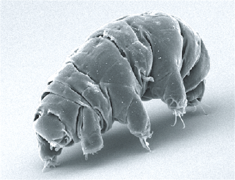The Cutest (not) Animals
I was shocked when looking back over this blog to discover that I don’t have an entry on Tardigrades. They are absolutely one of my favorite ‘animals’, and they deserve more publicity. I may even have done a piece on my old blog, but that one is dead and gone.
Anyway, the thing that got me thinking about tardigrades today, was this recent publication in Astrobiology (http://doi.org/10.1089/ast.2020.2405). Long story short, they fired tardigrades out of a high pressure gun and watched them go ‘splat’ (or not, depending on speed).
Let’s start at the beginning.
Tardigrades are delightful little microscopic creatures, ranging from about 0.1-1mm in length. They are the hardiest creatures you will ever find, able to survive radiation, extreme cold, extreme heat, extreme vacuum, extreme pressure, total dehydration, as well as much more. They are the classic ‘extremophile’. But also, they are really cute!

SEM image of Milnesium tardigradum in active state. doi:10.1371/journal.pone.0045682.g001 Schokraie E, Warnken U, Hotz-Wagenblatt A, Grohme MA, Hengherr S, et al. (2012) Creative Commons Attribution 2.5
Anyway, because of their hardy nature, tardigrades have been implicated in the “Panspermia” theory. This is the idea that ‘life’ that originates on one planet, might get spread around to others, for example on the back of a meteor or other space debris. And more importantly for future investigations, on human-sent spaceships. As I mentioned in my post on Life on Venus, one of the things we have to be really careful of, is not detecting ‘alien life’ when actually it’s just that the grad student didn’t sterilize the instrument properly before it left Earth…
Anyway, if these little critters did hitch a ride on a chunk of space debris, they would have to survive landing on another planet. And that’s no small thing. These landings often happen at speeds of more than several kilometers a second! But how to test it?
Shoot them out of a gun of course!
The researchers set up these poor little creatures to be fired from a gun into sand to mimic the moon’s surface. Then they measured their survival.
It turns out that these tough little guys can survive impacts at speeds of below 0.9 km/s, but faster than that and they start to go ‘splat’ (literally). If you check out the paper, the first image shows some happy alive tardigrades, and also a ‘chunk’ left over from an unhappy dead tardigrade.
What does this mean?
Well, for most space-junk collisions, this probably means that a tardigrade like this wouldn’t survive.
BUT…
- Impacts happen at different speeds, some faster, some slower. Hypothetically, these creatures could survive a slow impact
- There are different species of tardigrades that are more hardy than this one
- Sand is pretty hard… what if they collided with ‘planet marshmellow’? The impact force would be less, and survival would be higher
- Species smaller and simpler than tardigrades can survive much faster speeds.
I’ll unpack point 4 briefly. In terms of microbial organisms, tardigrades are pretty complex. Much bigger and more complex than say a bacteria. Bacteria can survive impacts at speeds of several kilometers a second. And even though survival rates may only be ~10%, you have to remember the sheer number scale we have to consider when dealing with these things. A million bacteria could fit into a 1 mm2 space. Which means that still 100,000 bacteria would survive, and that’s only 1 mm of them! That’s more than enough to take over and colonize a planet, given the right conditions and enough time.
But, bacteria are boring (and ugly) compared to tardigrades.
What does this all mean?
Well… it means that both bacteria and tardigrades could theoretically survive a crash-landing onto another planet. So they could potentially allow life to ‘hop’ from one planet to the next. Is that how life on Earth started? Maybe. We’ll probably never know. Has Earth live already ‘contaminated’ other planets? Also maybe – but that one we might find out, one day.
So, next time you’re faced with a tough situation, imagine you’re a tardigrade, and push through!
What do you think this finding means for ‘extra-terrestrial life’?
Do you wish you could own a pet tardigrade?
If you’d like to read the article in full, you can find it here: http://doi.org/10.1089/ast.2020.2405
For more science-related articles, go here: https://saffronbryant.com/category/science-fiction-becomes-reality/

Leave a Reply